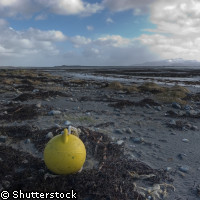Stressed seaweed affects coastal climate
An international study has now drawn a link between large brown seaweed and the coastal climate in seaweed-rich regions. According to the scientists, brown algae of the Laminariales (kelps) release inorganic iodine into the atmosphere when under stress, which may have an impact on cloud formation. The findings were published in the Proceedings of the National Academy of Science (PNAS). 'When kelp experience stress, for example when they are exposed to intense light, desiccation or atmospheric ozone during low tides, they very quickly begin to release large quantities of iodide from stores inside the tissues,' the lead author of the study, Dr Frithjof Küpper from the Scottish Association for Marine Science, says. These iodide ions are intended to protect the kelp from damage, as they detoxify ozone and other oxidising agents. The ions, however, produce molecular iodine in the process. This explains why the researchers found large amounts of iodine oxide and volatile halocarbons - compounds made up of carbon atoms and one or more halogen atoms such as fluorine, chlorine, bromine or iodine - in the atmosphere above kelp beds and forests. Kelps are thus an important factor in the global biochemical cycle of iodine and in the removal of ozone close to the Earth's surface. However, iodine oxide and halocarbons also act as condensation nuclei around which clouds may form. 'The increase in the number of cloud condensation nuclei may lead to 'thicker' clouds,' the paper's co-author, Dr Gordon McFiggans of the University of Manchester's School of Earth, Atmospheric and Environmental Sciences points out. 'These are optically brighter, reflecting more sunlight upwards and allowing less to reach the ground, and last for longer. In such a cloud there are a higher number of small cloud droplets and rainfall is suppressed, compared with clouds of fewer larger droplets.' As a result, the cloud cover over kelp-rich places, which in the UK include the Hebrides, Robin Hood's Bay and Anglesey, lasts longer and is more extensive, the scientists suspect. This could contribute to creating 'a much moodier, typically British coastal skyline,' Dr McFiggans says. Researchers from the UK, the Netherlands, Germany, France, Switzerland and the USA as well as the European Molecular Biology Laboratory (EMBL) contributed to the paper. The analysis was done with the help of x-ray absorption spectroscopy.
Countries
United Kingdom



